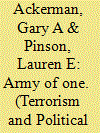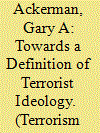|
|
|
Sort Order |
|
|
|
Items / Page
|
|
|
|
|
|
|
| Srl | Item |
| 1 |
ID:
132371


|
|
|
|
|
| Publication |
2014.
|
| Summary/Abstract |
In recent years, much of the literature on terrorist pursuits and use of unconventional weapons has focused on al-Qaeda and other Islamic extremist groups. Some scholars posit lone actors may differ from organizations when it comes to the observation that larger organizations are more likely to engage in chemical, biological, radiological, and nuclear (CBRN) activity, but leave this as an open question because of a prior lack of data on lone actors. Furthermore, new technologies and expanding networks may also spawn more deleterious lone actors, including what have been referred to as "super-empowered individuals." This article utilizes the Profiles of Incidents Involving CBRN by Non-State Actors Dataset and the Radiological and Nuclear Non-State Actors Database to illustrate the characteristics of CBRN pursuit by lone wolves and autonomous cells over time. Initial findings confirm the general perceptions that, historically, lone actors have engaged in cruder, smaller scale, and less frequent CBRN plots and attacks than their formal terrorist organization counterparts, but suggest that such actors do present a genuine threat, at least in terms of the potential for mass disruption. Additionally, while they share several similarities with more formal organizations, lone actors and autonomous cells tend to be motivated less by collective religious or ethno-nationalist concerns than larger organizations, focusing more on narrow or solipsistic drivers. Lone actors and autonomous cells also appear to largely calibrate their CBRN ambitions to their capabilities and their CBRN actions tend to receive better media coverage than formal terrorist organizations.
|
|
|
|
|
|
|
|
|
|
|
|
|
|
|
|
| 2 |
ID:
052518


|
|
|
|
|
| Publication |
2003.
|
| Summary/Abstract |
The Earth Liberation Front (ELF) is radical environmentalist group that has in the past engaged in profile acts of arson, thus far without causing casualties. In order to determine the correct level of official response, it is necessary to examine the potential for the ELF and other radical environmentalist groups to engage in various levels of violence against human beings. Using empirically-based threat assessment, this study investigates the motivational and capability-related attributes of the ELF and concludes that there is a moderate-high threat of an escalation to internationally targeting people, a moderate probability that its members will at some point seek to inflict mass casualties and a low potential for ELF attacks using unconventional weapons. The assessment also identifies several factors indicating that the threat of all three types of violence is increasing, although determining the magnitude of this increase requires further study. Recommendations are given for law enforcement strategies with respect to the ELF and similarly-oriented radical groups.
|
|
|
|
|
|
|
|
|
|
|
|
|
|
|
|
| 3 |
ID:
110855


|
|
|
|
|
| Publication |
2012.
|
| Summary/Abstract |
Despite plentiful scholarship relating to the prospect of terrorists utilizing chemical, biological, radiological, or nuclear (CBRN) weapons, little of this work is both quantitative in nature and global in scope. Leveraging open-source data, this study quantitatively explores factors influencing the terrorist organizational decision to pursue CBRN weapons. The findings suggest that organizations embedded in alliance structures and based in authoritarian countries with relatively strong connections to a globalized world are more likely to seek to develop or acquire CBRN weapons. Contrary to previous qualitative studies, the present study failed to find a significant relationship between CBRN pursuit and religious ideology.
|
|
|
|
|
|
|
|
|
|
|
|
|
|
|
|
| 4 |
ID:
179983


|
|
|
|
|
| Summary/Abstract |
The majority of scholarship on chemical, biological, radiological, and nuclear (CBRN) terrorism relies on non-empirical theorizing or the in-depth examination of a handful of prominent cases. A key reason for the dearth of systematic analyses is the lack of a comprehensive database on CBRN terrorism events amenable to quantitative analysis. This article introduces the Profiles of Incidents involving CBRN and Non-State Actors (POICN) database, consisting of 517 CBRN terrorism–related events from 1990 to 2017. After laying out the general scope of the database and its unique approach to incident validation, the article illustrates POICN’s potential through preliminary observations of the data.
|
|
|
|
|
|
|
|
|
|
|
|
|
|
|
|
| 5 |
ID:
144892


|
|
|
|
|
| Summary/Abstract |
Open-source event data sets frequently used for social science analysis rarely provide any transparent explanation of the credibility of sources or the validity of data thereby obtained. We develop a sample Source Evaluation Schema for the purpose of operationalizing measures of open-source event validity at the case, source, and variable levels. Based on our findings, we argue that explicitly incorporating and disclosing credibility and validity levels allows for greater flexibility in tailoring the inclusion of cases for researchers' specific analytical requirements. By facilitating more transparent analyses, the inclusion of such measures in similar datasets can result in more defensible conclusions, especially in highly charged political and security contexts such as those surrounding terrorism.
|
|
|
|
|
|
|
|
|
|
|
|
|
|
|
|
| 6 |
ID:
183008


|
|
|
|
|
| Summary/Abstract |
While conventional wisdom holds that the ideology espoused by a terrorist organization is somehow related to that organization’s actions, the precise nature of the relationship between these phenomena is hotly debated, with scholarship often yielding contrasting empirical results. We argue that one reason for this divergence in viewpoints and research findings is an inadequate understanding of what ideology actually is and how it relates to terrorism. Indeed, the terrorism literature reveals widely disparate uses of the concept of terrorist ideology. This article endeavors to provide a common framework for approaching ideology in the context of terrorism studies by systematically building a new definition of terrorist ideology from first principles. In so doing, we introduce a definition of terrorist ideology that is logically consistent, has robust theoretical underpinnings, and connects the study of ideology within terrorism to broader disciplinary research traditions regarding ideology. This provides a conceptual foundation from which to examine terrorist ideology in an objective, systematic manner and thereby enables terrorism researchers to more productively investigate important outstanding questions, such as which aspects of an ideology are most relevant to violent behavior.
|
|
|
|
|
|
|
|
|
|
|
|
|
|
|
|
|
|
|
|
|